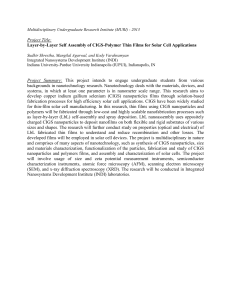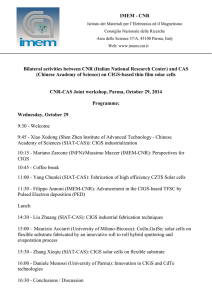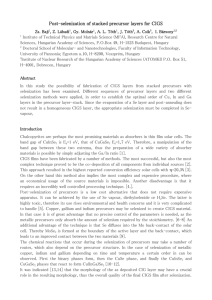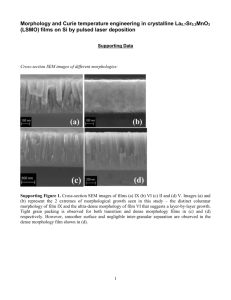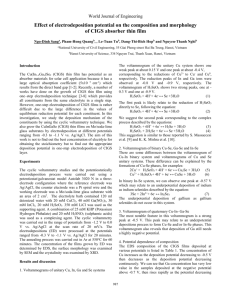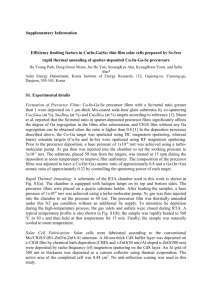Preparation of CIGS films by coevaporation and post selenization of
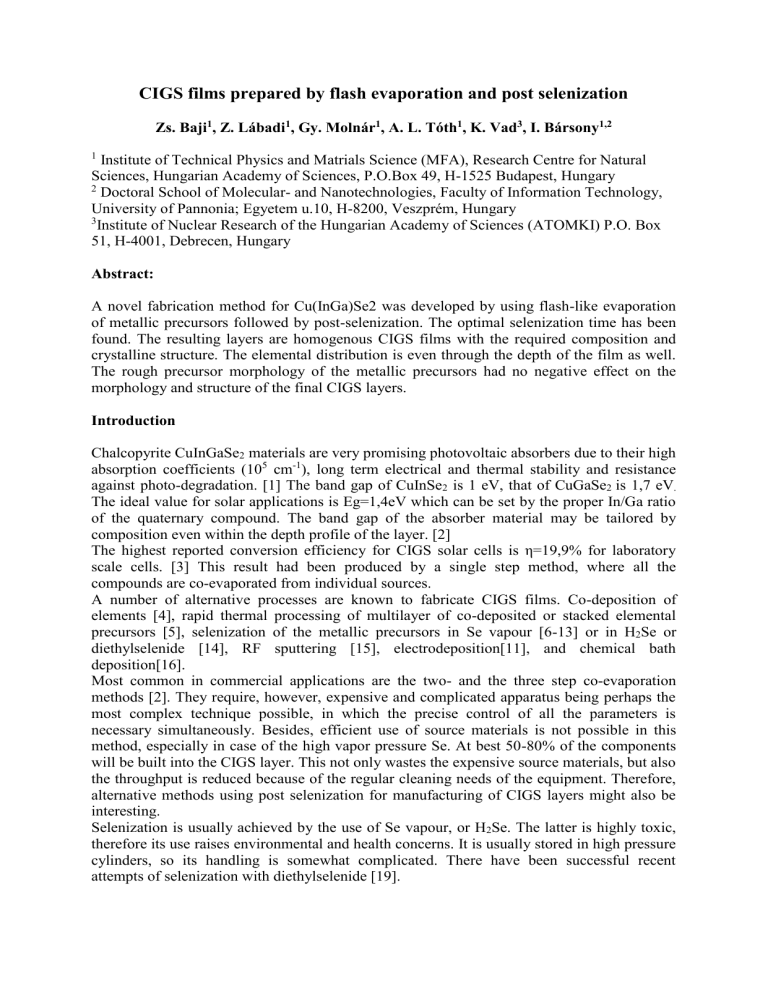
CIGS films prepared by flash evaporation and post selenization
Zs. Baji 1 , Z. Lábadi 1 , Gy. Molnár 1 , A. L. Tóth 1 , K. Vad 3 , I. Bársony 1,2
1
Institute of Technical Physics and Matrials Science (MFA), Research Centre for Natural
Sciences, Hungarian Academy of Sciences, P.O.Box 49, H-1525 Budapest, Hungary
2
Doctoral School of Molecular- and Nanotechnologies, Faculty of Information Technology,
University of Pannonia; Egyetem u.10, H-8200, Veszprém, Hungary
3 Institute of Nuclear Research of the Hungarian Academy of Sciences (ATOMKI) P.O. Box
51, H-4001, Debrecen, Hungary
Abstract:
A novel fabrication method for Cu(InGa)Se2 was developed by using flash-like evaporation of metallic precursors followed by post-selenization. The optimal selenization time has been found. The resulting layers are homogenous CIGS films with the required composition and crystalline structure. The elemental distribution is even through the depth of the film as well.
The rough precursor morphology of the metallic precursors had no negative effect on the morphology and structure of the final CIGS layers.
Introduction
Chalcopyrite CuInGaSe
2
materials are very promising photovoltaic absorbers due to their high absorption coefficients (10
5
cm
-1
), long term electrical and thermal stability and resistance against photo-degradation. [1] The band gap of CuInSe
2
is 1 eV, that of CuGaSe
2 is 1,7 eV
.
The ideal value for solar applications is Eg=1,4eV which can be set by the proper In/Ga ratio of the quaternary compound. The band gap of the absorber material may be tailored by composition even within the depth profile of the layer. [2]
The highest reported conversion efficiency for CIGS solar cells is η=19,9% for laboratory scale cells. [3] This result had been produced by a single step method, where all the compounds are co-evaporated from individual sources.
A number of alternative processes are known to fabricate CIGS films. Co-deposition of elements [4], rapid thermal processing of multilayer of co-deposited or stacked elemental precursors [5], selenization of the metallic precursors in Se vapour [6-13] or in H
2
Se or diethylselenide [14], RF sputtering [15], electrodeposition[11], and chemical bath deposition[16].
Most common in commercial applications are the two- and the three step co-evaporation methods [2]. They require, however, expensive and complicated apparatus being perhaps the most complex technique possible, in which the precise control of all the parameters is necessary simultaneously. Besides, efficient use of source materials is not possible in this method, especially in case of the high vapor pressure Se. At best 50-80% of the components will be built into the CIGS layer. This not only wastes the expensive source materials, but also the throughput is reduced because of the regular cleaning needs of the equipment. Therefore, alternative methods using post selenization for manufacturing of CIGS layers might also be interesting.
Selenization is usually achieved by the use of Se vapour, or H
2
Se. The latter is highly toxic, therefore its use raises environmental and health concerns. It is usually stored in high pressure cylinders, so its handling is somewhat complicated. There have been successful recent attempts of selenization with diethylselenide [19].
The quality of the readily deposited CIGS material can be largely improved by a selenization with simultaneous annealing. Another advantage of the selenization method is that during this process Se diffuses into the Mo back contact of the solar cell as well, and MoSe
2
is formed on the boundary of the two materials. This results in an improved contact resistivity between the active layer and the back contact of the solar cell. Controversially, the Se content of the layers is not always increased by selenization, as the out-diffusion of the Se from the deposited layer is also possible.
There were a number of studies dealing with the selenization of Cu, In and Ga, but no full description of the individual mechanisms is given yet. There is no detailed analysis of the diffusion of Se in the metallic precursors either. The influence of parameters such as time, pressure and temperature on the diffusion is not yet understood. Most studies examine the process by ex-situ methods, but there were certain attempts to use in situ characterisation of
CIGS formation. Liu et al [8] used in situ electrical resistance measurement, while Kim et al.
[17] applied time-resolved high temperature XRD.
On the other hand several studies address the chemical reactions in the process. It has been established that following the Cu-Se reactions (190-230°C), the In-Se reactions (225-265 °C), and the Ga-Se reactions (255-460°C) the phases CuInSe
2
and CuGaSe
2
are produced, which finally react to form Cu(InGa)Se
2
.[9]
It was suggested [7] that the morphology of the as deposited CIG layer may have a crucial role on the resulting morphology, thus the overall quality of the CIGS film after selenization.
Both evaporated and sputtered CIG layers are inhomogeneous usually with a rough surface, which is considered to make the preparation of good quality CIGS layer by selenization difficult. The reason for the phenomenon has not yet been fully explained.
The aim of this work is to present a new way of fabricating CIGS material by co-evaporating
Cu, In and Ga precursors from a single source followed by post-selenization; and to study the effects of the precursor morphology and the selenization parameters on the CIGS material.
Experimental
The three metallic components were simultaneously evaporated from a resistively heated single evaporation source (boat) which is similar to using an alloy-like source, except that the alloy only forms whilst heating the source. The evaporation of the metals is defined by their vapour pressure at any given temperature. Because of the Raoult’s law the evaporation rate of the different components varies during the process at given boat temperature, therefore the composition of the layer may also vary with time. In order to produce the required overall stoichiometry, the quantity of the material to be evaporated has to be chosen such, that, the whole content of the source will be evaporated. Otherwise the lower vapour pressure components that evaporate later would remain in the boat. The best efficiency solar cells can be expected at the following atomic ratio of the components: In:Ga:Cu/0,8:0,2:1.
The evaporation took place from a Ta boat covered with a W foil. In order to avoid Ga-Ta alloy formation Ga and In pieces were placed onto a thin Cu foil which served as the source of copper as well. This method was feasible since the evaporation of copper requires the highest temperature. The evaporation took place at ~1x10
-6
Torr background pressure. The estimated temperature of the source was between 1500-2000ºC where all components were flash- evaporated intensively. The thickness was monitored with an oscillating quartz, setting the average density of the components to 7,39 g/cm
3
. The substrates were 2x2 cm
2
soda lime glass pieces cleaned in cc.HNO
3
and in high purity water before layer deposition. During evaporation substrate temperature did not exceed 50°C.
For the post-selenization of the layers CIG samples with Se pellets were sealed into glass ampoules evacuated to 10
-2
Torr. In order to obtain the Cu(In,Ga)Se
2 phase they were heated for 5, 10, 15 or 20 minutes to 500ºC and 520°C.
For characterization of the layers XRD measurements were performed with Cu K
radiation using a Bruker AXS D8 Discover horizontal X-ray diffractometer equipped with Göbel mirror and a two dimensional GADDS detector system. The beam diameter was about 500
m.
Scanning electron microscopy analysis was carried out in a LEO 1540 XB microscope equipped with a Schottky field emission gun, a Gemini lens system and in-lens detector.
The depth profile analyses were recorded by Secondary Neutron Mass Spectrometry (SNMS,
Specs GmbH, Berlin). An inductively coupled low-pressure radio frequency Ar discharge was used to provide sample bombardment and post ionization. The samples were bombarded with
Ar+ ions extracted from the plasma with the use of high-frequency negative bias on the sample. The bombarding energy was 350 eV. The concentrations were determined using relative sensitivity factors of the constituents. The sputtering time was converted to depth scale from sputtering rates determined by a high-sensitivity surface profiler.
Results and discussion
Fig. 1. shows SEM morphology and EDS maps of the flash evaporated CIG precursor film.
The secondary electron image (Fig. 1.a) displays a rough surface morphology with micron sized hills. EDS spectra of the distribution of In, Cu and Ga (Figs. 1.b, c and d respectively) show the elemental distribution of the precursor metals which is laterally inhomogenous.
However, the indium – which evaporated first - formed micron size droplets on the surface, which were then covered with granular layers of gallium and copper. Average granulum size of Cu and Ga is 0,1μm.
Fig.2. shows the SEM images of the CIGS sample selenized at 500°C for 15 min. It is important to stress that the morphology seen in the secondary electron image of Fig.2.a shows a much smoother surface than the one in Fig.1.a.
Systematic examination of the samples demonstrated that already 5 minutes of selenization resulted in smooth and homogenous layers, according to the EDS results with a composition corresponding to the required value. Fig. 2.b-2.d reflect that the elemental distribution of the
15 min selenized layer became homogenous.
Fig. 3. shows a secondary electron image of the layer. The CIGS films exhibit the cauliflower-like structure mentioned in the literature [12]. The tetragonal shaped crystallites typical of chalcopyrite structure are also apparent in the image.
Fig. 4. plots the X-ray diffraction results of the post-selenized samples at 500°C for different lengths of time between 5 and 20 min. Fig. 4.a shows XRD spectra between the 15-75° 2Θ range of the spectrum. It is evident from this figure, that only the diffraction peaks of the chalcopyrite structure are present, no oxides or selenides are visible. Fig. 4.b is a zoomed-out part of the previous image, and shows the (204) (220) peaks of the samples. It is apparent that selenization time only affects the Ga content. According to the XRD results the composition of all the samples falls in the range of CuIn
0,9
Ga
0,1
Se
2 and CuIn
0,7
Ga
0,3
Se
2
. The samples selenized for 10 and 15 min have the composition of CuIn
0,8
Ga
0,2
Se
2
considered ideal for photovoltaic application. The sample selenized for 5 min has a somewhat lower Ga content, while the 20 min sample has the composition of CuIn
0,7
Ga
0,3
Se
2
.
The SNMS depth profiles are presented in Fig. 5. The surface of the layers is very rough, covered occasionally with micron sized structures and islands. This represents a non-ideal sample for an SNMS measurement since there is no definite reference plain for the start of the
analysis, which results in the apparent smear-out of the depth profiles. Therefore, the depth distribution of the elements can only be evaluated in qualitative terms.
According to literature data [17,18] a main drawback of the post-selenization method is that the obtained CIGS layers tend to have a Ga accumulation in the vicinity of the back contact.
This means that the Ga diffuses from the top of the layer towards the back contact. This results in a Ga-poor, -thereby narrower band gap layer near the active region of the film. At the same time with the formation of an In-rich layer at the top and a Ga-rich one at the bottom a phase separation of CIS and CGS layers became possible. However, the SNMS profiles of our samples showed no sign of this Ga-pileup, the Ga-content is largely uniform throughout the cross section of the film.
Conclusions
A novel fabrication method for Cu(InGa)Se
2
was developed by using flash-like evaporation of metallic precursors followed by post-selenization. The main advantage of this method is its simplicity.
Unlike the processes using consecutive evaporation or simultaneous co-evaporation of precursors from multiple sources, this flash method evaporates the metallic components from a single boat at the same time. Post-selenization was carried out in sealed ampoules under constant Se vapour-pressure. The resulting layers are homogenous CIGS films with the required composition and crystalline structure.
Contrary to Su et al. [7] we found no negative effect of the rough precursor morphology on the morphology and structure of the final CIGS layers. The post selenization not only forms the absorber layer but also smoothens the CIG morphology. The composition CuIn
0,8
Ga
0,2
Se
2 considered ideal for photovoltaic application was found in samples selenized for 10 to 15 min.
SNMS spectra of the film proved the uniform Ga concentration across the whole thickness.
Acknowledgement
The authors with to thank the Hungarian National Science Fund OTKA (Grant No. NK73424) for the support. This work was also supported by the National Development Agency grant
*TÁMOP-4.2.2/B-10/1-2010-0025*
References
1. O. Volobujevaa, M.Altosaara, J.Raudojaa, E.Mellikova, M. Grossberga, L.Kaupmeesa,
P.Barvinschib, SEM analysis and selenization of Cu–In alloy films produced by cosputtering of metals , Sol. Energy Mater. Sol. Cells 93 (2009) 11–14
2.
R. Klenk, M. C. Lux-Steiner, Chalcopyrite Based Solar Cells, in J. Poortmans, V.
Arkhipov (Eds) Thin Film Solar Cells, Wiley, 2006
3.
I. Repins, M A. Contreras, B. Egaas, C DeHart, J Scharf, C. L. Perkins, B. To, R.
Noufi, 19·9%-efficient ZnO/CdS/CuInGaSe 2 solar cell with 81·2% fill factor
†
, Prog
Photovolt Res Appl. 16 (2008) 235-239.
4. M. Powallaa, B. Dimmler, Development of large-area CIGS modules, Sol. Energy Mater.
Sol. Cells 75 (2003) 27–34
5. M. Klenk, O. Schenker, V. Alberts, E. Bucher, Preparation of device quality chalcopyrite thin films by thermal evaporation of compound materials, Semic. Sci. And Technol. 17
(2002)435-439
6. M. Kaelin, D. Rudmann, F. Kurdesau, H. Zogg, T. Meyer, A.N. Tiwary, Low-cost CIGS solar cells by paste coating and selenization, Thin Solid Films 480-481 (2005) 486-490
7. C.-Y. Su, W.-H. Ho, H.-C. Lin, C.-Y. Nieh, S.-C. Liang, The effects of the morphology on the CIGS thin films prepared by CuInGa single precursor, Sol. Energy Mater. Sol.
Cells, 95 (2011) 261-263
8. W. Liu, J.-G. Tian, Q. He, F.-Y. Li, Y. Sun, Effect of metallic precursors on the thin film thickness and reaction resistances in the selenization process, Curr. Appl. Phys, (2010) doi:10,1016/j.cap.2010,07,028
9. W. Liu, J.-G. Tian, W. He, F.-Y. Li, C.-J. Li, Y. Sun In-situ electrical resistance measurement of the selenization process in the CuInGa-Se system, Thin Solid Films 519
(2010) 244-250
10. W. Li, Y. Sun, W. Liu, L. Zhou, Fabrication of Cu(InGa)Se2 thin films solar cell by selenization process with Se vapor, Sol. Energ. 80 (2006) 191-195
11 M. Ganchev, J. Kois, M. Kaelin, S. Bereznev, E. Tzvetkova, O. Volobujeva, N. Stratieva,
A. Tiwari, Preparation of Cu(In,Ga)Se2 layers by selenization of electrodeposited Cu-In-
Ga precursors, Thin Solid Films 511-512 (2006) 325-327.
12. R. Caballero, C. Maffiotte, C. Guillén, Preparation and characterization fo CuIn
1-x
Ga x
Se
2 thin films obtained by sequential evaporations and different selenization processes, Thin
Solid Films 474 (2005) 70-76.
13. G. S. Chen, J.C. Yang, Y.C. Chan, L.C. Yang, W. Huang, Another route to fabricate single-phase chalcogenides by post-selenization of Cu-In-Ga precursors sputter deposited from a single ternary target, Sol. Energy Mater. Sol. Cells 93 (2009) 1351-1355.
14.
Ankur A. Kadam, Neelkanth G. Dhere, Higly efficiet CuIn1-xGaxSe2-ySy/CdS thin -film solar cells by using diethylselenide as selenium precursor
Solar Energy Materials and Solar Cells, Volume 94 (2010) 738-743.
15.
H. K. Song, S. G. Kim, H. J. Kim, Sol. Energ. Mater. Sol. Cells 75 (2003) 145.
16.
C. H. Huang, S. S. Li, W. N. Shafarman, Sol. Energ. Mater. Sol. Cells 69 (2001) 131
17. W.K. Kim, E.A. Payzant, T.J. Anderson, O.D. Crisalle, In situ investigation of the selenization kinetics of Cu–Ga precursors using time-resolved high-temperature X-ray diffraction, Thin Solid Films 515 (2007) 5837–5842
18. N. G. Dhere, S.S. Kulkarni, A. H. Jahagirdar, A. A. Kadam, Composition and morphology of partially selenized CuIn1-xGaxSe2 thin films prepared using diethylselenide as selenium source, J. Phys and Chem. Of sol. 66 (2005) 1876-1879
19. M. Sugiyama, F.B. Dejene, A. Kinoshita, M. Fukaya, Y. Maru, T. Nakagawa, H.
Nakanishi, V. Alberts, S.S. Chichibu, The use of diethylselenide as a less hazardous source in CuInGaSe2 photoabsorbing alloy formation by selenization of metal precursors premixed with Se, J. Crystal Growth, 294 (2006) 214-217)
Fig.1. SEM morphology and EDS maps of flash evaporated CIG precursor film. a: secondary electron image, b – d: In, Cu, Ga distributions, respectively.
Fig. 2. SEM image of the CIGS sample selenized at 500°C for 15 minutes, and elemental distribution maps of the constituents..
Fig. 3. SEM micrograph of the flash evaporated and post selenized (500°C for 15 min) CIGS layer. Note the cauliflower-like morphology.
Fig. 4. XPS results obtained on the CIGS layers post-selenized at 500°C for differentn durations.
Only the diffraction peaks of the chalcopyrite structure are present, no oxides or selenides are visible, whatsoever. Note that selenization time only affects the Ga content in the zoomed-in intensity plot below.
100
80
Si
Cu
Ga
In
Se 60
40
20
0
0 100 200 300 400 500 600 700 800
Depth [nm]
Fig 5. SNMS depth profiles of the CIGS layer selenized at 500° for 15 minutes
